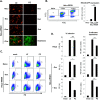Evaluating the Biological Role of Lassa Viral Z Protein-Mediated RIG-I Inhibition Using a Replication-Competent Trisegmented Pichinde Virus System in an Inducible RIG-IN Expression Cell Line
- PMID: 35913216
- PMCID: PMC9400496
- DOI: 10.1128/jvi.00754-22
Evaluating the Biological Role of Lassa Viral Z Protein-Mediated RIG-I Inhibition Using a Replication-Competent Trisegmented Pichinde Virus System in an Inducible RIG-IN Expression Cell Line
Abstract
Lassa virus (LASV) is a mammarenavirus that can cause lethal Lassa fever disease with no FDA-approved vaccine and limited treatment options. Fatal LASV infections are associated with innate immune suppression. We have previously shown that the small matrix Z protein of LASV, but not of a nonpathogenic arenavirus Pichinde virus (PICV), can inhibit the cellular RIG-I-like receptors (RLRs), but its biological significance has not been evaluated in an infectious virus due to the multiple essential functions of the Z protein required for the viral life cycle. In this study, we developed a stable HeLa cell line (HeLa-iRIGN) that could be rapidly and robustly induced by doxycycline (Dox) treatment to express RIG-I N-terminal effector, with concomitant production of type I interferons (IFN-Is). We also generated recombinant tri-segmented PICVs, rP18tri-LZ, and rP18tri-PZ, which encode LASV Z and PICV Z, respectively, as an extra mScarlet fusion protein that is nonessential for the viral life cycle. Upon infection, rP18tri-LZ consistently expressed viral genes at a higher level than rP18tri-PZ. rP18tri-LZ also showed a higher level of a viral infection than rP18tri-PZ did in HeLa-iRIGN cells, especially upon Dox induction. The heterologous Z gene did not alter viral growth in Vero and A549 cells by growth curve analysis, while LASV Z strongly increased and prolonged viral gene expression, especially in IFN-competent A549 cells. Our study provides important insights into the biological role of LASV Z-mediated RIG-I inhibition and implicates LASV Z as a potential virulence factor. IMPORTANCE Lassa virus (LASV) can cause lethal hemorrhagic fever disease in humans but other arenaviruses, such as Pichinde virus (PICV), do not cause obvious disease. We have previously shown that the Z protein of LASV but not of PICV can inhibit RIG-I, a cytosolic innate immune receptor. In this study, we developed a stable HeLa cell line that can be induced to express the RIG-I N-terminal effector domain, which allows for timely control of RIG-I activation. We also generated recombinant PICVs encoding LASV Z or PICV Z as an extra gene that is nonessential for the viral life cycle. Compared to PICV Z, LASV Z could increase viral gene expression and viral infection in an infectious arenavirus system, especially when RIG-I signaling is activated. Our study presented a convenient cell system to characterize RIG-I signaling and its antagonists and revealed LASV Z as a possible virulence factor and a potential antiviral target.
Keywords: Lassa; Lassa virus; Pichinde; Pichinde virus; RIG-I; RIG-I signaling; Z protein; arenavirus; inducible expression; innate immune evasion; innate immunity; recombinant viruses; tri-segmented arenavirus; viral virulence.
Conflict of interest statement
The authors declare no conflict of interest.
Figures







Similar articles
-
Lassa virus protein-protein interactions as mediators of Lassa fever pathogenesis.Virol J. 2025 Feb 28;22(1):52. doi: 10.1186/s12985-025-02669-y. Virol J. 2025. PMID: 40022100 Free PMC article. Review.
-
Characterization of bi-segmented and tri-segmented recombinant Pichinde virus particles.J Virol. 2024 Oct 22;98(10):e0079924. doi: 10.1128/jvi.00799-24. Epub 2024 Sep 12. J Virol. 2024. PMID: 39264155 Free PMC article.
-
The Z proteins of pathogenic but not nonpathogenic arenaviruses inhibit RIG-I-like receptor-dependent interferon production.J Virol. 2015 Mar;89(5):2944-55. doi: 10.1128/JVI.03349-14. Epub 2014 Dec 31. J Virol. 2015. PMID: 25552708 Free PMC article.
-
Virulent infection of outbred Hartley guinea pigs with recombinant Pichinde virus as a surrogate small animal model for human Lassa fever.Virulence. 2020 Dec;11(1):1131-1141. doi: 10.1080/21505594.2020.1809328. Virulence. 2020. PMID: 32799623 Free PMC article.
-
Current research for a vaccine against Lassa hemorrhagic fever virus.Drug Des Devel Ther. 2018 Aug 14;12:2519-2527. doi: 10.2147/DDDT.S147276. eCollection 2018. Drug Des Devel Ther. 2018. PMID: 30147299 Free PMC article. Review.
Cited by
-
Lassa virus Z protein hijacks the autophagy machinery for efficient transportation by interrupting CCT2-mediated cytoskeleton network formation.Autophagy. 2024 Nov;20(11):2511-2528. doi: 10.1080/15548627.2024.2379099. Epub 2024 Jul 20. Autophagy. 2024. PMID: 39007910 Free PMC article.
-
Lassa virus protein-protein interactions as mediators of Lassa fever pathogenesis.Virol J. 2025 Feb 28;22(1):52. doi: 10.1186/s12985-025-02669-y. Virol J. 2025. PMID: 40022100 Free PMC article. Review.
References
-
- Buchmeier MJ, de la Torre J-C, Peters CJ. 2013. Arenaviridae, p 1283–1303. In Fields Virology, 6th ed Philadelphia: Wolters Kluwer Health/Lippincott Williams & Wilkins.
Publication types
MeSH terms
Substances
Grants and funding
LinkOut - more resources
Full Text Sources

